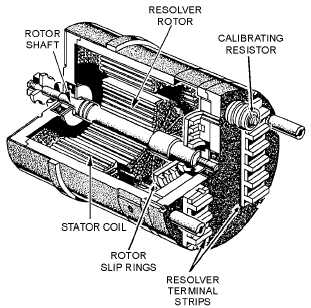4-7
A step-transmission system is not self-synchronizing, and its limited number of steps does not permit
data to be transmitted smoothly or where relatively small changes in data are required. This type of
transmission system is cheap, rugged, and relatively powerful.
Q-2. Compare the power sources of synchros and step-transmission systems.
Q-3. A step transmitter is a modification of what electrical device?
RESOLVERS
The last device we will discuss is the resolver. Physically, resolvers are similar to synchros, and are
used to perform mathematical computations electrically. They are rotary electromechanical devices that
provide outputs that are trigonometric functions of their inputs. As you may know, the branch of
mathematics that deals with the quantities and angles of a right triangle is known as trigonometry. Many
"trig" problems that can be solved with paper and pencil can be solved by applying the proper electrical or
mechanical quantities to a resolver. The resolver has the advantage of giving instantaneous solutions if the
input quantities are changing continuously.
Resolvers are classified according to size (diameter) in the same manner as standard synchros and
may be mounted with most standard synchro mounting hardware. A cutaway view of a resolver is shown
in figure 4-5.
Figure 4-5.—Cutaway view of a resolver.
Notice that the stator of the resolver is a cylindrical structure of slotted laminations on which two
coils are wound. The rotor is composed of a shaft, laminations, two windings, and four slip rings.
Compensator components, which improve the angular accuracy of resolvers, may consist of resistors or
additional windings in the stator and rotor winding circuits. Compensator windings, which increase the
accuracy of the resolver, are located inside the stator. Compensating (calibrating) resistors, which

